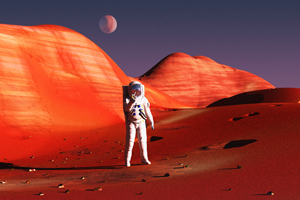
Entries open for 2020 Student Design Competition
What would it take to make a manned mission to Mars a reality? A team of aerospace and textile engineering students from North Carolina State University believe part of the solution may lie in advanced textile materials. The students joined forces to tackle life-support challenges that the aerospace industry has been grappling with for decades. "One of the big issues, in terms of a manned mission to Mars, is creating living quar

29th June 2011
Innovation in Textiles
|
Raleigh, NC

What would it take to make a manned mission to Mars a reality? A team of aerospace and textile engineering students from North Carolina State University believe part of the solution may lie in advanced textile materials.
The students joined forces to tackle life-support challenges that the aerospace industry has been grappling with for decades.
"One of the big issues, in terms of a manned mission to Mars, is creating living quarters that would protect astronauts from the elements - from radiation to meteorites," says textile engineering student Brent Carter.
"Currently, NASA uses solid materials like aluminium, fibreglass and carbon fibres, which while effective, are large, bulky and difficult to pack within a spacecraft."
Using advanced textile materials, which are flexible and can be treated with various coatings; students designed a 1900-square-foot inflatable living space that they say could comfortably house four to six astronauts.
The living space is made by layering radiation-shielding materials like Demron (said to be used in the safety suits for nuclear workers cleaning up Japan's Fukushima plant) with a gas-tight material made from a polyurethane substrate to hold in air, as well as gold-metalicized film that reflects UV rays.
According to the students the space is dome-shaped, which will allow meteors, prone to showering down on the red planet, to bounce off the astronauts' home away from home without causing significant damage.
"We're using novel applications of high-tech textile technology and applying them to aerospace problems," explains Alex Ray, a textile engineering student and team member.
"Being able to work with classmates in aeronautical engineering allowed us to combine our knowledge from both disciplines to really think through some original solutions."
The students say they also tackled another major issue preventing a manned mission to Mars - water supply, as currently, astronauts utilize something called a Sabatier reactor to produce water while in space.
The Sabatier process involves the reaction of carbon dioxide and hydrogen, with the presence of nickel, at extremely high temperatures and pressure to produce water and methane.
"We wanted to find a way to improve the current Sabatier reactor so we could still take advantage of the large quantities of carbon dioxide available on Mars, and the fact that it is relatively easy to bring large quantities of hydrogen on the spacecraft, since it is such a lightweight element," says recent aerospace engineering graduate Mark Kaufman, who was also on the design team.
Current Sabatier reactors, Kaufman explains, are long, heavy tubes filled with nickel pellets - not ideal for bringing on a spacecraft. The student groups worked to develop a fibre material to which they applied nickel nanoparticles to create the same reaction without all the weight and volume. They believe their redesigned Sabatier reactor would be more feasible to carry along on a future space shuttle.
In addition to Carter, Ray and Kaufman, the team also included Kris Tesh, Grant Gilliam, Kasey Orrell, Daniel Page and Zack Hester. Textile engineering professor and former aerospace engineer, Dr. Warren Jasper, and Dr. Andre Mazzoleni, associate professor of mechanical and aerospace engineering, served as the faculty sponsors. The team also received valuable feedback from Fred Smith, an advanced life support systems engineer with NASA.
Jasper and the student team will present their project at the NASA-sponsored Revolutionary Aerospace Systems Concepts Academic Linkage (RASC-AL) competition, held June 6-8 in Cocoa Beach, Fla. The project will be judged by NASA and industry experts against other undergraduate groups from across the country.
RASC-AL was formed to provide university-level engineering students the opportunity to design projects based on NASA engineering challenges, as well as offer NASA access to new research and design projects by students.

Business intelligence for the fibre, textiles and apparel industries: technologies, innovations, markets, investments, trade policy, sourcing, strategy...
Find out more